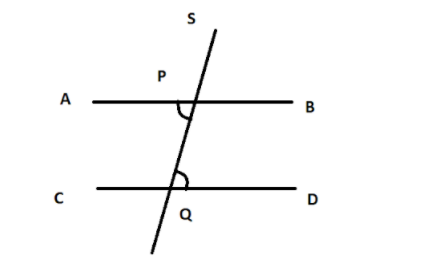
Suppose a transversal cuts two distinct straight lines such that pairs of alternate angles are equal, then prove that the two lines are parallel to each other.
Answer
574.5k+ views
Hint: We are given two lines and one line intersecting the two lines. We will use the property of “vertically opposite angles are equal” to prove the lines are parallel. And we will add our given properties to prove the given statement.
Complete step-by-step answer:
Here we are to prove: \[AB\parallel CD\]
Proof:

We have two straight lines AB and CD such that when transversal line intersects line AB at P and line CD at Q, a pair of alternate interior angles is equal.
\[ \Rightarrow \;\;\angle APQ = \angle PQD\;{\text{ }}\;{\text{ }}\;{\text{ }}\;\] [Given] -- ( 1 )
When 2 lines intersect then we have, Vertically opposite angles are equal, hence we get,
\[ \Rightarrow \;\;\angle APQ = \angle SPB\;{\text{ }}\;{\text{ }}\;{\text{ }}\;\] -- ( 2 )
From ( 1 ) and ( 2 ), we get
\[ \Rightarrow \;\;\angle SPB = \angle PQD\]
If we take lines AB and CD, we can see that a pair of corresponding angles is equal.
This means line AB is parallel to CD.
\[\therefore \;\;AB\parallel CD\;{\text{ }}\;{\text{ }}\;{\text{ }}\;{\text{ }}\;{\text{ }}\;\]
Hence, proved.
Note: If a set of 2 parallel lines, line l and line m, are crossed or cut by another line, line n, we say "a set of parallel lines are cut by a transversal. Each of the parallel lines cut by the transversal has 4 angles surrounding the intersection. These are matched in measure and position with a counterpart at the other parallel line.
Complete step-by-step answer:
Here we are to prove: \[AB\parallel CD\]
Proof:

We have two straight lines AB and CD such that when transversal line intersects line AB at P and line CD at Q, a pair of alternate interior angles is equal.
\[ \Rightarrow \;\;\angle APQ = \angle PQD\;{\text{ }}\;{\text{ }}\;{\text{ }}\;\] [Given] -- ( 1 )
When 2 lines intersect then we have, Vertically opposite angles are equal, hence we get,
\[ \Rightarrow \;\;\angle APQ = \angle SPB\;{\text{ }}\;{\text{ }}\;{\text{ }}\;\] -- ( 2 )
From ( 1 ) and ( 2 ), we get
\[ \Rightarrow \;\;\angle SPB = \angle PQD\]
If we take lines AB and CD, we can see that a pair of corresponding angles is equal.
This means line AB is parallel to CD.
\[\therefore \;\;AB\parallel CD\;{\text{ }}\;{\text{ }}\;{\text{ }}\;{\text{ }}\;{\text{ }}\;\]
Hence, proved.
Note: If a set of 2 parallel lines, line l and line m, are crossed or cut by another line, line n, we say "a set of parallel lines are cut by a transversal. Each of the parallel lines cut by the transversal has 4 angles surrounding the intersection. These are matched in measure and position with a counterpart at the other parallel line.
Recently Updated Pages
Master Class 8 Social Science: Engaging Questions & Answers for Success

Master Class 8 Maths: Engaging Questions & Answers for Success

Master Class 8 Science: Engaging Questions & Answers for Success

Class 8 Question and Answer - Your Ultimate Solutions Guide

Master Class 8 English: Engaging Questions & Answers for Success

Why are manures considered better than fertilizers class 11 biology CBSE

Trending doubts
What is BLO What is the full form of BLO class 8 social science CBSE

Citizens of India can vote at the age of A 18 years class 8 social science CBSE

Full form of STD, ISD and PCO

Right to vote is a AFundamental Right BFundamental class 8 social science CBSE

What is the difference between rai and mustard see class 8 biology CBSE

Summary of the poem Where the Mind is Without Fear class 8 english CBSE





